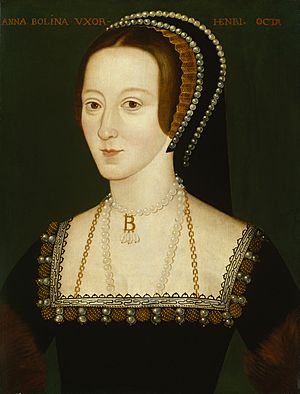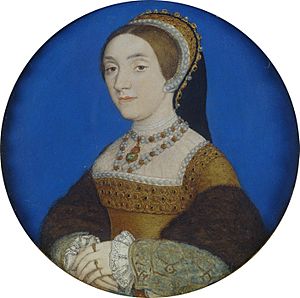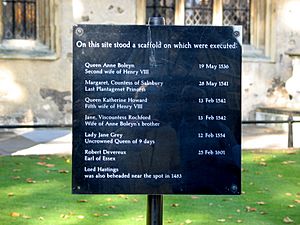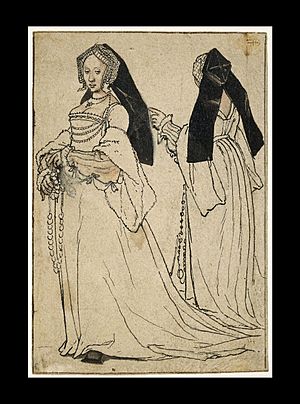Jane Boleyn, Viscountess Rochford facts for kids
Quick facts for kids Jane Boleyn |
|
|---|---|
| Viscountess Rochford | |
| Born | Jane Parker c. 1505 Norfolk, England |
| Died | 13 February 1542 (aged 36–37) Tower of London, England |
| Buried | Chapel Royal of St. Peter ad Vincula, Tower of London 51°30′31″N 0°04′37″W / 51.508611°N 0.076944°W |
| Noble family | Boleyn |
| Spouse(s) | |
| Father | Henry Parker, 10th Baron Morley |
| Mother | Alice St John |
Jane Boleyn, Viscountess Rochford (née Jane Parker; c. 1505 – 13 February 1542), was an English noblewoman. Her husband, George Boleyn, Viscount Rochford, was the brother of Anne Boleyn, the second wife of King Henry VIII. Jane had been a member of the household of Henry's first wife, Catherine of Aragon. It is possible that she played a role in the verdicts against, and subsequent executions of, her husband and Anne Boleyn. She was later a lady-in-waiting to Henry's third and fourth wives, and then to his fifth wife, Catherine Howard, with whom she was executed.
Contents
Early life
Born Jane Parker, she was the daughter of Henry Parker, 10th Baron Morley, and Alice St John, great-granddaughter of Margaret Beauchamp of Bletso. Through Margaret, Jane was a distant relation of King Henry VIII — specifically his half-second-cousin – and this, in turn, made her a second cousin once removed of all of the King's children, including her niece-by-marriage, Elizabeth I. She was born in Norfolk around the year 1505; her family were wealthy, well-connected, politically active and respected members of the English nobility. Her father was an intellectual, with a great interest in culture and education. She was sent to the royal court in her early teens, certainly before her fifteenth birthday, where she joined the household of King Henry VIII's first wife, Catherine of Aragon. She is recorded as having accompanied the royal party on the state visit to France in 1520, "The Field of the Cloth of Gold".
Although it has long been supposed that nothing is recorded of Jane's appearance (and there is no surviving portrait that can be identified as her), her biographer Julia Fox, in Jane Boleyn: The Infamous Lady Rochford, suggests that there is a very remote chance that a Holbein painting represents a likeness of Jane. Meanwhile, she considers "the best impression we can have of Jane Rochford is Holbein’s drawings of an unknown woman in Tudor dress" (pp. 317–319). She was probably considered attractive, given that she was chosen to appear as one of the lead actresses/dancers in the prestigious "Château Vert" masquerade at Court in 1522. The seven performers were selected from the ladies of court in large part for their attractiveness, including the King's sister Mary Tudor, Dowager Queen of France. Two of the other performers included Jane's future sisters-in-law, Anne and Mary Boleyn.
Marriage
In late 1524 or early 1525, she was married to George Boleyn (later Viscount Rochford), brother of Anne Boleyn, who later became the second queen of Henry VIII. At this stage, however, Anne was not completely attached to the King, although she was already one of the leaders of fashionable society.
As a wedding present, King Henry gave Jane and George Grimston Manor in Norfolk. Since she gained the courtesy title of Viscountess Rochford in 1529 when her husband was made a viscount, she was usually known at court (and by subsequent historians) as "Lady Rochford". As the Boleyn family's wealth and influence increased, the couple were given the Palace of Beaulieu in Essex as their chief residence, which George and Jane decorated with a lavish chapel, a tennis court, a bathroom with hot-and-cold running water, imported carpets, mahogany furniture and their own large collection of silverware. Their marital bed was draped in cloth of gold with a white satin canopy, linen quilts and a yellow counterpane. Beaulieu had initially belonged to the Boleyns as one of their country retreats before they sold it to the King, who spent over £17,000 lavishly refurbishing and expanding it. In the early 1530s, it became the main residence of his eldest daughter, Mary, but when she was banished to Hatfield House, Viscount Rochford was given the house to live in, although the deeds were never formally signed over.
The exact nature of her relationship with her royal sister-in-law Anne is not clear, and there is no evidence as to what she thought of her other sister-in-law, Mary Boleyn, who had been at court with Jane since they were both teenagers. It is generally assumed that Jane was not overly fond of Anne, allegedly because of Jane's jealousy of her.

Widowhood
George Boleyn was executed on Tower Hill on 17 May 1536. His final speech was chiefly concerned with promoting his new-found Protestant faith. Four other men were executed alongside him. Anne was executed two days later within the walls of the Tower of London. Anne's poise and courage at the scaffold were much commented upon, and public opinion in the weeks and months after often "made of Anne a persecuted heroine, bright with promise and goodness as a young woman, beautiful and elegant." It is not known whether Jane witnessed the execution of either her husband or her sister-in-law, but the posthumous sympathy Anne aroused in many meant that many of those linked to her fall were cast in the roles of villains. According to Julia Fox, this explains how Jane's actions were construed as being those of a cruel and jealous intriguer.
The immediate aftermath of the fall of the Boleyns was hard for her, both socially and financially. The lands which the Boleyns had built up during Anne Boleyn's reign and over the previous four generations, including the titles Earl of Wiltshire and Earl of Ormond, were to pass through the male line only, and thus were lost to the family with George's death. Jane continued to use the courtesy title of Viscountess Rochford but without a son she could not benefit from what remained of the Boleyn family fortune. (Modern rumours that George Boleyn, Dean of Lichfield, a colourful character, was the child of Jane and George are now thought to be false.)
Later political intrigues

After her husband's execution, Lady Rochford was absent from court for several months. She spent this time securing her financial position by negotiations with her father-in-law, Sir Thomas Boleyn, but mainly with Thomas Cromwell. The Boleyns eventually allocated her an annual pension of £100, precisely what they had given Mary Boleyn when she had been widowed eight years earlier. It was much less than her previous income, but it was enough to keep her as a noblewoman, which was essential for her return to court, something Jane worked doggedly for. It is unknown when she returned to court, but she was a lady-in-waiting to Queen Jane Seymour, so she probably returned within a year of her husband's death. As a viscountess, she was allowed to bring a number of her own servants with her, lodge in the King's palaces, and be addressed as "Lady Rochford".
Following Jane Seymour's death, the King subsequently married Anne of Cleves, a German princess recommended by Cromwell. However, Henry soon wanted to be rid of Anne, and sought an annulment. The king annulled the marriage and married Catherine Howard, who was related to the Boleyn family through the Howards.
Lady Rochford kept her post as lady-in-waiting, now to Queen Catherine. Queen Catherine's past indiscretions were uncovered in the autumn of 1541, and her private life was investigated. The Queen was first detained in her apartments and then placed under house arrest at Syon Abbey, a disused convent. Her confidantes and favourites were questioned and their rooms searched. Lady Rochford was herself detained for questioning, implicated in arranging meetings between the Queen and Thomas Culpeper.
Downfall and execution

During her imprisonment in the Tower, Lady Rochford was interrogated but was not tortured. However, she seems to have suffered a nervous breakdown and by the beginning of 1542 was pronounced insane. Jane was thus condemned to death by an Act of Attainder, and the execution date was set for 13 February 1542, the same day as Queen Catherine's execution.
The Queen died first, apparently in a weak physical state, although she was not hysterical.
Jane was executed and was buried in the church of St Peter ad Vincula within the Tower of London alongside Queen Catherine, close to the bodies of Anne Boleyn and Jane's husband George Boleyn.
Genealogical table
In fiction and media
Literature
Lady Rochford has appeared in numerous novels, especially those on Anne Boleyn and Catherine Howard. Vengeance Is Mine by Brandy Purdy is written from Lady Rochford's viewpoint. She also features in Robin Maxwell's The Secret Diary of Anne Boleyn, Suzannah Dunn's The Queen of Subtleties and briefly in Margaret George's The Autobiography of Henry VIII. Jane's character is also mentioned in Wendy J. Dunn's Dear Heart, How Like You This? which is based on the life of the poet Thomas Wyatt. Rochford is a minor character in Sovereign, the third instalment of C. J. Sansom's Shardlake series of murder mystery novels. A larger role is given to Lady Rochford in Jean Plaidy's novel The Rose Without a Thorn. Jane Rochford also appears in the Thomas Cromwell trilogy by Hilary Mantel.
Jane appears in the historical novel The Other Boleyn Girl by Philippa Gregory, which tells the story of her other sister-in-law, Mary Boleyn. One of its sequels is The Boleyn Inheritance, which casts Lady Rochford as one of its lead characters and its central villain. It details the final three years of her life and her involvement with Anne of Cleves and Catherine Howard. The Raven's Widow by Adrienne Dillard takes a much different tack to previous portrayals. Lady Rochford is shown as a beloved wife and close friend to the Boleyns, her later role in the relationship between Catherine Howard and Thomas Culpeper coming about because of the trauma of her husband's death and the knowledge that disobedience comes at a price.
Film and TV
In the 1970 BBC series The Six Wives of Henry VIII starring Keith Michell as Henry, Sheila Burrell portrayed Lady Rochford.
In the 2003 TV drama Henry VIII, Lady Rochford was played by Kelly Hunter. In the film adaptation of Philippa Gregory's novel The Other Boleyn Girl, Jane Boleyn (played by Juno Temple) was a minor character. In both these representations, Jane was shown as being a political tool in the hands of her husband's uncle, the Duke of Norfolk, although the presentation of her in The Other Boleyn Girl was more sympathetic. In the 2003 TV adaptation of Gregory's novel, Jane was played by Zoe Waites.
Jane is also represented in seasons two to four of the Showtime series The Tudors, by Joanne King with Padraic Delaney playing her husband George. In this version, their marriage is miserable, with both pressured into it by their parents. They are shown frequently arguing. However, Jane is not shown as hating Anne and so her betrayal of the Boleyns is motivated by her hatred of George. She befriends Jane Seymour when she becomes Queen, is made her lady-in-waiting and remains a close friend until Queen Jane's death. She remains chief lady-in-waiting, first to Anne of Cleves and then Catherine Howard.
In Wolf Hall, a TV mini-series adaptation of the historical novel by Hilary Mantel, she was played by Jessica Raine. Her portrayal, while consistent with negative depictions of her, also stems from the disrespect and neglect she is shown experiencing from both Anne and George Boleyn, which makes her a ready accomplice to the intrigues of Thomas Cromwell.



